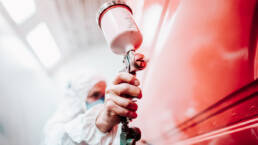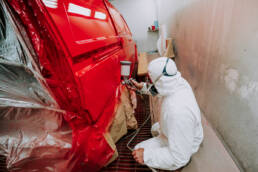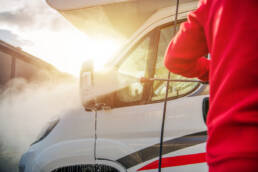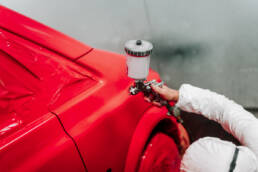Every car owner has experienced that heart-sinking moment when their beloved vehicle sustains damage, be it a minor dent, a noticeable scratch, or more extensive structural issues. Auto body repair in Denver is the art of restoring a vehicle’s appearance and structural integrity after an accident or wear and tear. It’s a crucial service that not only enhances the aesthetics of your car but also ensures your safety on the road.
The auto body repair process, is everything from minor dents to full restorations. Whether you’re a curious car enthusiast or a concerned vehicle owner seeking to understand the repair process better, this guide is here to enlighten you.
We will begin by laying the foundation, understanding the basics of auto body repair and the various types of damage that may require attention. From there, we’ll take you on a step-by-step journey through the entire repair process, from assessment and estimation to advanced techniques like paintless dent repair and structural damage repair.
The Basics of Auto Body Repair
What is Auto Body Repair?
Auto body repair refers to the process of restoring a vehicle’s exterior components and structure to their original condition after sustaining damage. This can include repairing dents, scratches, paint damage, and more severe structural issues caused by collisions. The goal of auto body repair is not only to restore the vehicle’s aesthetics but also to ensure its safety and functionality.
Types of Damage Requiring Auto Body Repair
- Dents and Dings
Dents and dings are common forms of damage that can occur due to various incidents, such as minor accidents, hailstorms, or parking lot mishaps. These damages can be unsightly and may also affect the resale value of the vehicle. - Scratches and Scuffs
Surface scratches and scuffs can occur from contact with various objects, such as shopping carts, tree branches, or other vehicles. While some scratches may be shallow and easily repairable, deeper ones can expose the underlying metal, making it susceptible to rust and corrosion if left untreated. - Paint Damage and Fading
Over time, a car’s paint may begin to fade, peel, or chip due to exposure to the elements, UV rays, and environmental pollutants. Proper paint repair and restoration are vital not only for cosmetic purposes but also to protect the vehicle’s metal surfaces from rust and deterioration. - Structural Damage
Structural damage can result from more severe accidents or collisions. This type of damage affects the vehicle’s framework, compromising its structural integrity and potentially endangering the occupants’ safety. Structural repairs require specialized equipment and expertise to ensure the vehicle is restored to its original strength and safety standards.
The Auto Body Repair Process
Assessment and Estimation
The auto body repair process begins with a thorough assessment of the vehicle’s damage. Skilled technicians inspect the entire exterior, interior, and undercarriage to identify all areas that require repair. This assessment helps create an accurate estimate of the repair costs.
- Visual Inspection
During the visual inspection, technicians identify visible damages, such as dents, scratches, and broken parts. - Computerized Scanning and Diagnostics
For more advanced vehicles, computerized scanning and diagnostics are used to detect hidden damages that may not be visible during the initial inspection. - Cost Estimation
Based on the assessment, the repair shop provides an estimate of the repair costs, including labor, parts, and paint, allowing the vehicle owner to make informed decisions and plan accordingly.
Preparing for Repair
Once the assessment is complete, the repair process moves to the preparation stage, where the vehicle is readied for repairs.
- Cleaning and Disassembly
The vehicle is thoroughly cleaned to remove any dirt, debris, or contaminants that might interfere with the repair process. In some cases, certain components may need to be disassembled to access the damaged areas more effectively. - Identifying Hidden Damage
Disassembling the vehicle may reveal hidden damages that were not initially visible during the visual inspection. These hidden damages are then added to the repair plan. - Parts Ordering
If replacement parts are required, the repair shop orders them, ensuring that the right parts are available before beginning the repairs.
Advanced Auto Body Repair Techniques
Paintless Dent Repair (PDR)
Paintless Dent Repair (PDR) is a specialized technique used to repair minor dents without the need for repainting. Skilled technicians use specialized tools to carefully massage and manipulate the metal back into its original shape. PDR is most effective for small dents caused by hail, door dings, and minor collisions.
- Tools and Equipment Used
PDR technicians use various tools, such as metal rods and picks, along with specially designed tabs and glues to access the backside of the dent and gently push it back into place. - Limitations and Suitability
PDR is not suitable for all types of dents. Larger and more severe dents, as well as those with cracked or chipped paint, may require traditional dent repair methods.
Understanding the Role of Fillers and Adhesives
In some cases, auto body repair technicians use fillers and adhesives to repair certain types of damage and imperfections.
- Types of Fillers and Their Uses
Fillers are used to fill in gaps and imperfections on the vehicle’s surface, such as deeper scratches or dents that cannot be repaired with PDR. They help create a smooth surface for painting and finishing. - Structural Adhesives in Auto Body Repair
Structural adhesives are strong bonding agents used in modern car construction and repairs. They provide structural strength and rigidity when repairing components like roof panels, pillars, and quarter panels. The use of adhesives in auto body repair requires specialized training and equipment.
The Importance of Professional Auto Body Repair
- Safety Considerations
Auto body repairs play a critical role in maintaining the safety of your vehicle. Properly repaired and aligned structural components ensure that the vehicle can withstand impacts and collisions, protecting the occupants in the event of an accident. - Insurance and Warranties
Opting for professional auto body repair from reputable shops often comes with additional benefits. Many insurance policies cover auto body repairs, making it cost-effective for vehicle owners. Moreover, professional repair shops typically offer warranties on their work, giving you peace of mind knowing that your vehicle is covered if any issues arise after the repairs. - Preserving the Vehicle’s Value
When it comes to reselling or trading in your vehicle, its appearance and condition significantly impact its value. A well-maintained and professionally repaired car will command a higher resale value compared to one with visible damages and shoddy repairs.
Choosing a reliable and experienced auto body repair shop is crucial to ensure the best possible outcome for your vehicle. A reputable shop will have skilled technicians, state-of-the-art equipment, and a track record of delivering high-quality repairs.
Full Auto Restorations: Taking Auto Body Repair to the Next Level
What is a Full Auto Restoration?
A full auto restoration involves bringing a classic or vintage vehicle back to its original factory condition or even better, often including both mechanical and cosmetic enhancements. These projects require meticulous attention to detail, extensive research, and a passion for preserving automotive history.
Choosing the Right Restoration Shop
Undertaking a full auto restoration is a significant investment of time and money. It is crucial to select a restoration shop that specializes in the specific make and model of your vehicle. Look for experienced restoration experts with a portfolio of successfully completed projects and positive customer testimonials.
The Step-by-Step Restoration Process
A full auto restoration typically follows a structured process, which may include the following stages:
- Disassembly and Documentation
The vehicle is disassembled, and every component is carefully documented and cataloged. This step ensures that each part is accounted for and can be accurately restored or replaced. - Rust and Corrosion Removal
Classic cars often suffer from rust and corrosion, which must be diligently removed to restore the vehicle’s structural integrity and aesthetics. - Panel Fabrication and Replacement
Some classic car parts may be challenging to find, so skilled restoration shops can fabricate custom panels or source high-quality replacements. - Engine and Mechanical Restoration
Restoring the vehicle’s engine and mechanical components is essential for optimal performance and reliability. - Interior Upholstery and Detailing
The interior is meticulously restored with attention to period-correct materials and finishes. - Painting and Finishing Touches
The vehicle undergoes a painstaking painting process, ensuring an immaculate and authentic appearance.
Classic Car Restoration vs. Modern Car Restoration
While classic car restorations focus on preserving originality and historical accuracy, modern car restorations often involve customizations and modern upgrades, creating a blend of vintage aesthetics and contemporary performance.
DIY Auto Body Repair: Pros and Cons
Small Repairs You Can Do Yourself
For minor scratches and dents, DIY auto body repair may seem tempting, and there are DIY kits available for such repairs. However, it’s essential to know the limitations of DIY repairs and when it’s best to seek professional help.
Risks and Challenges of DIY Repairs
DIY repairs can lead to subpar results, potentially causing more damage and reducing the vehicle’s resale value. Lack of proper tools, training, and expertise may result in unsightly repairs that are easily noticeable.
When to Seek Professional Help
It’s advisable to consult professional auto body repair shops for any significant damage or when unsure about the extent of the repairs needed. Skilled technicians can accurately assess the damage and provide appropriate solutions for a safe and effective repair.
Tips for Finding a Reliable Auto Body Repair Shop
Research and Recommendations
Conduct thorough research online and seek recommendations from friends, family, or car enthusiasts. Look for reviews and testimonials to gauge the quality of service provided by a specific repair shop.
Certifications and Qualifications
Choose a shop with certified technicians who have received training from recognized institutions. Certifications from organizations such as I-CAR (Inter-Industry Conference on Auto Collision Repair) indicate a commitment to industry standards and best practices.
Reviews and Testimonials
Customer reviews can provide valuable insights into the level of customer satisfaction and the overall reputation of the auto body repair shop.
Understanding the auto body repair process is essential for any vehicle owner, from those dealing with minor dents and scratches to those considering full restorations. Auto body repair ensures that your car remains safe, visually appealing, and retains its value over time.
From the basics of auto body repair to advanced techniques like paintless dent repair and the intricacies of full auto restorations, this blog has taken you on a journey through the world of automotive restoration.
While small DIY repairs can be attempted, entrusting your car to a professional auto body repair shop like Premium Automotive in Denver, is crucial for more significant damages and complex projects. Their expertise, specialized tools, and attention to detail will ensure your vehicle receives the care it deserves. Schedule an appointment online.
Whether you have a classic car waiting to be restored to its former glory or simply want to maintain your everyday vehicle’s appearance, remember that professional auto body repair not only enhances your car’s aesthetics but also safeguards your safety and investment on the road. So, choose wisely, and let the skilled hands of auto body repair experts bring back the shine to your beloved ride.
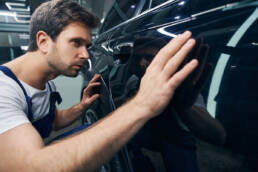
We will repair your vehicle with competence and consideration! Let us get the job done right for you the first time and take the stress out of auto body repairs!
Like this article? Spread the word!
Related Posts
April 23, 2024
Savings and Benefits: How Paintless Dent Removal Can Preserve Your Car’s Value
Preserve your car's value with paintless dent removal. Premium Automotive in Aurora,…
March 15, 2024
Protecting Your Vehicle’s Paint Job: Top Tips to Prevent Chips, Scratches, and Fading
Protect your vehicle's paint job from chips, scratches, and fading with expert tips from…
February 15, 2024
When Paintless Dent Removal Works Best: Assessing Dent Types and Suitability
Discover the benefits of Paintless Dent Removal (PDR) at Premium Automotive in Aurora.…


